MobileHelp Medical Alert System Cost and Pricing in 2025
MobileHelp’s contract-free, affordable plans and robust product lineup start at $24.95 per month.
SeniorLiving.org is supported by commissions from providers listed on our site. Read our Editorial Guidelines
Founded in 2006, MobileHelp is best known for affordable monitoring for spouses, long-range at-home systems, and high-tech features. Backed by U.S.-based Rapid Response, a monitoring center that provides rigorous training to its employees, MobileHelp offers six reliable alert systems to meet the needs of people who are aging in place. With a range of products and packages, MobileHelp offers something for most budgets and needs. From pricing to value, we’ll cover everything you need to know about MobileHelp’s offerings below.
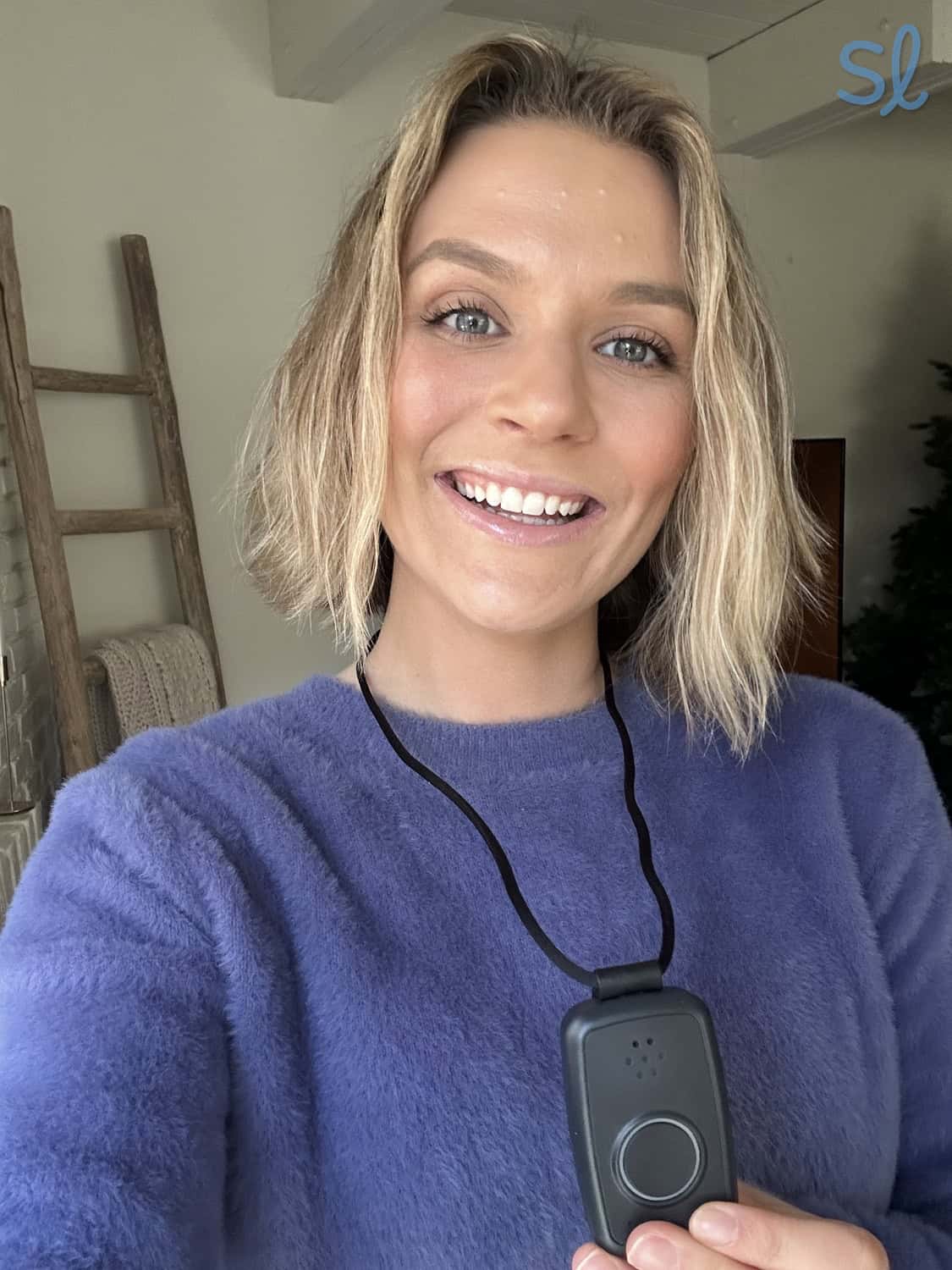
Using the MobileHelp Micro system

MobileHelp at a Glance
- Large at-home range (up to 1,400 feet)
- Two-for-the-price-of-one systems
- Affordable packages with monthly, quarterly, and annual payment plans
- No long-term contracts
- Landline and cellular options
- 24/7 U.S.-based professional monitoring
- UL-certified equipment
- No activation or equipment fees
- Free lockbox with all systems
The Fast Facts: MobileHelp’s Equipment and Pricing
| Product | Monthly starting prices | System functionality | Connection type | Activation fees |
|---|---|---|---|---|
| Classic Cellular | $24.95 | At-Home | Cellular | $0 |
| Classic Landline | $24.95 | At-Home | Landline | $0 |
| MobileHelp Solo | $34.95 | On-the-Go | Cellular | $0 |
| MobileHelp Micro | $34.95 | On-the-Go | Cellular | $0 |
| Home Duo Bundle | $44.95 | In-Home and On-the-Go | Cellular | $0 |
| Mobile Duo Bundle | $49.95 | In-Home and On-the-Go | Cellular | $0 |
A Closer Look at MobileHelp’s Systems and Value
MobileHelp offers a wide variety of at-home, on-the-go, and hybrid systems for most budgets. Their least expensive system, the Classic Cellular, starts at $24.95 per month, which is affordable compared to most of the competition. For a closer look at another affordable brand that, like MobileHelp, doesn’t skimp on quality, check out Bay Alarm Medical’s prices and packages. For comparison, Bay Alarm Medical’s prices for in-home systems start at $24.95 per month, while Medical Guardian’s monthly cost is $32.95.
Back to MobileHelp. You can add automatic fall detection to most packages (excluding MobileHelp Wired Home) for $11 per month. We tested MobileHelp’s medical alert systems and found that the average response time was around 30 seconds, which falls at the middle of the industry average of between 15 and 45 seconds. Read on for a breakdown of every MobileHelp system!
Classic Cellular
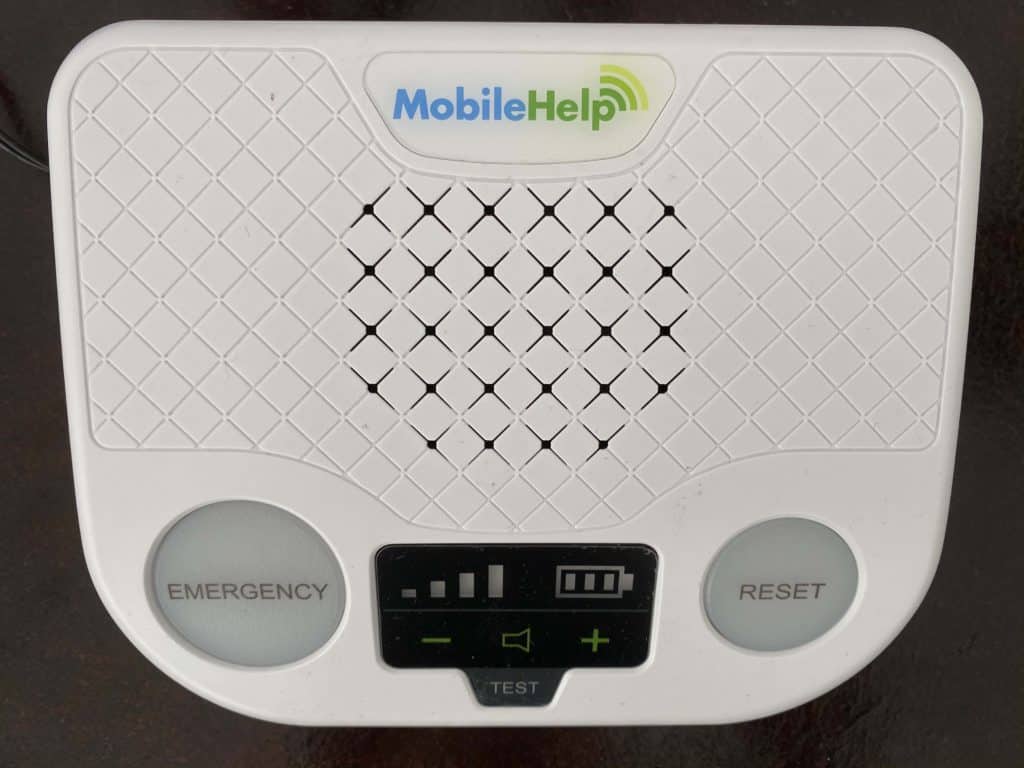
MobileHelp Base Unit
Starting at just $24.95 per month, the Classic Cellular comes with a wearable waterproof help button and an in-home base unit. In an emergency, users can call for help by pressing either the base station or pendant button, connecting them to a live operator at a 24/7 monitoring center. In addition, the Classic offers optional fall detection for an extra $11 monthly fee.
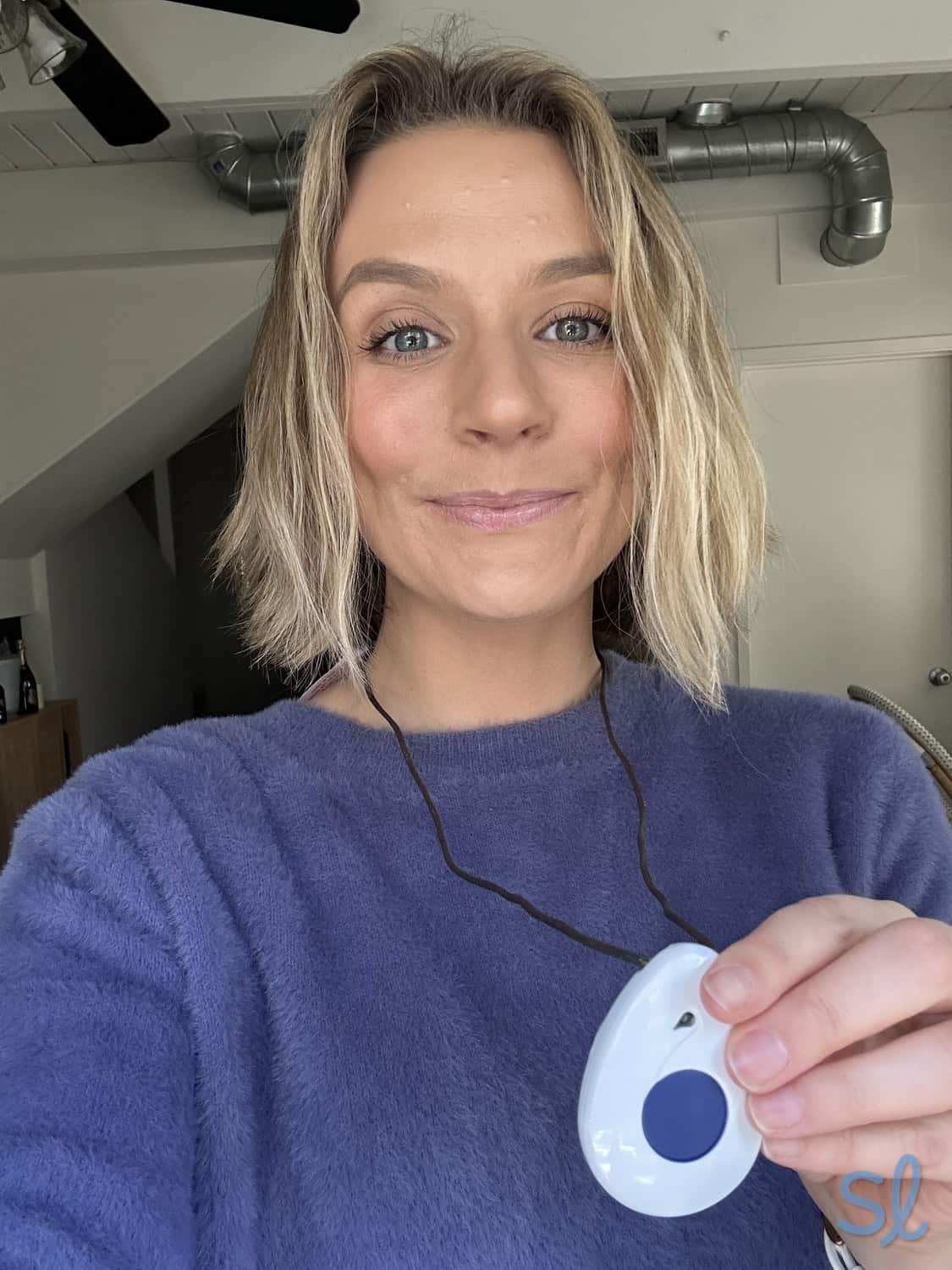
Using MobileHelp's fall detection pendant
The base station features big buttons and lights up, which makes it easy to use and see at night. Plus, we really like the display that shows your battery level and signal strength. It also features a test button directly below the display.
With an impressive at-home range of 1,400 feet, MobileHelp blows out of the water other at-home systems from providers we’ve reviewed, such as Medical Alert (which offers a range of 600 feet). If you live in an area with solid AT&T coverage and you’re looking for a reliable at-home system that doesn’t require a landline connection, Classic is a great choice.
When we pressed the help button on the pendant and base station, we were connected to MobileHelp’s response center in 30 seconds. It’s also good to know that in a power outage, the base unit has a backup battery that powers it for up to 24 hours.
We really liked the magnet breakaway neck lanyard, an important safety feature to prevent strangulation. In our testing, we found the lanyard and wristband to be light and easy to wear. However, the wristband could improve by having a hidden buckle that goes under your wrist like with Apple watches.
Classic Landline
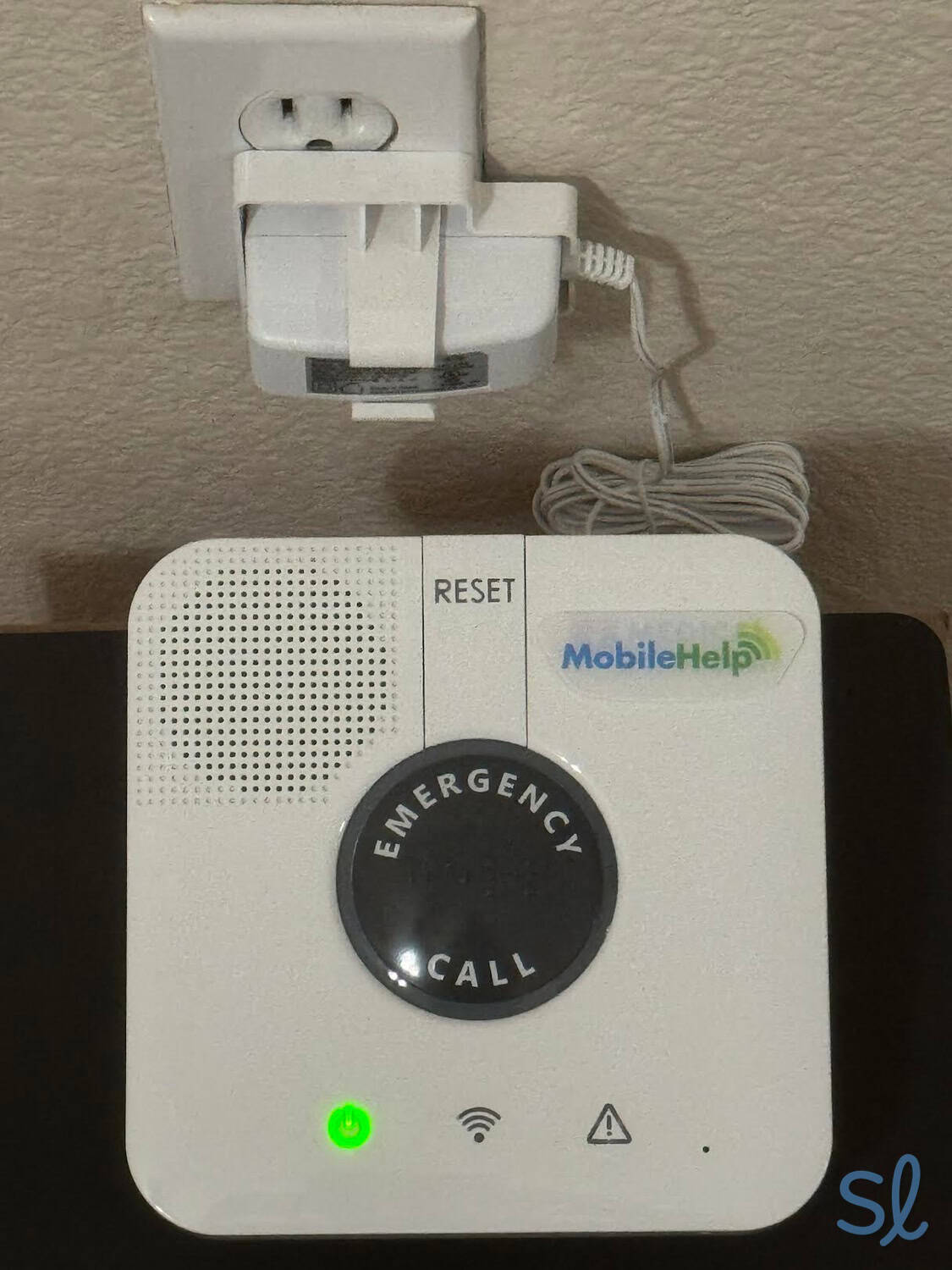
Using MobileHelp's Classic Landline system
Classic Landline, the company’s at-home landline system, starts at $24.95 per month and is best for people who spend lots of time at home. It operates just like Classic Cellular, except it needs to be connected to a phone jack and comes with a six foot phone cord.
The system is a good solution if you spend most of your time at home and live in an area with poor cell reception, since it provides a reliable connection at a great value and has a coverage area up to 1,300 feet. We found that the lightweight, square-shaped base station was easy to use. It has a large round black button in the center that says EMERGENCY CALL in big letters, so you can’t miss it. It works with a wearable help button and offers two-way communication capability in your home with a built-in speaker. One thing the at-home system does not offer, however, is fall detection.
Pro Tip: MobileHelp Connect is an online portal with a mobile app that can be downloaded to your smartphone. It offers standard (free) and premium (for an additional charge) features. Standard features include caregiver alerts when an older loved one presses the help button, location detection for caregivers, and a MobileVitals section to store important health information.
MobileHelp Solo
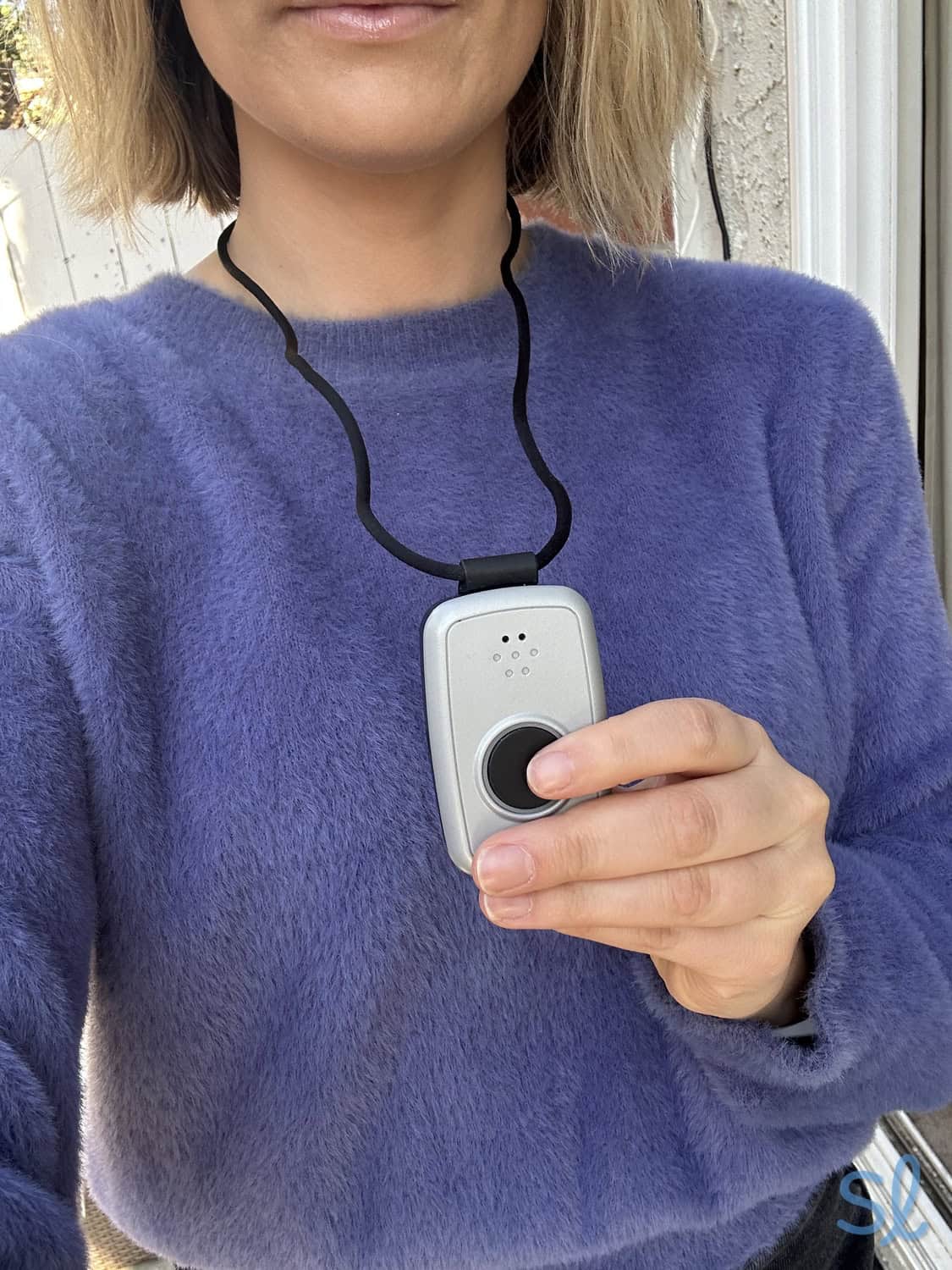
Using MobileHelp's Solo system
MobileHelp Solo is an affordable on-the-go option that costs $34.95 per month. The mobile device can be worn like a necklace, so you can take it with you wherever there’s reliable AT&T service. It also comes with a small pendant help button, so you can throw it in a pocket and put on the pendant if you don’t want to wear the larger system.
In our testing, we found Solo to be on the larger and heavier side compared to the smaller and lighter SOS Micro system from Bay Alarm Medical. But, on the positive side, it doesn’t come with a bulky base station to occupy precious counter space. It’s a great option, even if you spend a lot of time at home, and it comes with a charger and a help button. It is simple to call for help and has a large button in the center. The battery on the neck pendant and wrist button will last over five years.
The device takes three hours to fully charge and includes two-way talk, GPS location tracking, and a 36-hour battery life. When you see a red blinking light, it means you have one hour left of the battery, which is good to know to ensure it’s charged enough before using. When the light turns solid green, that means it is fully charged.
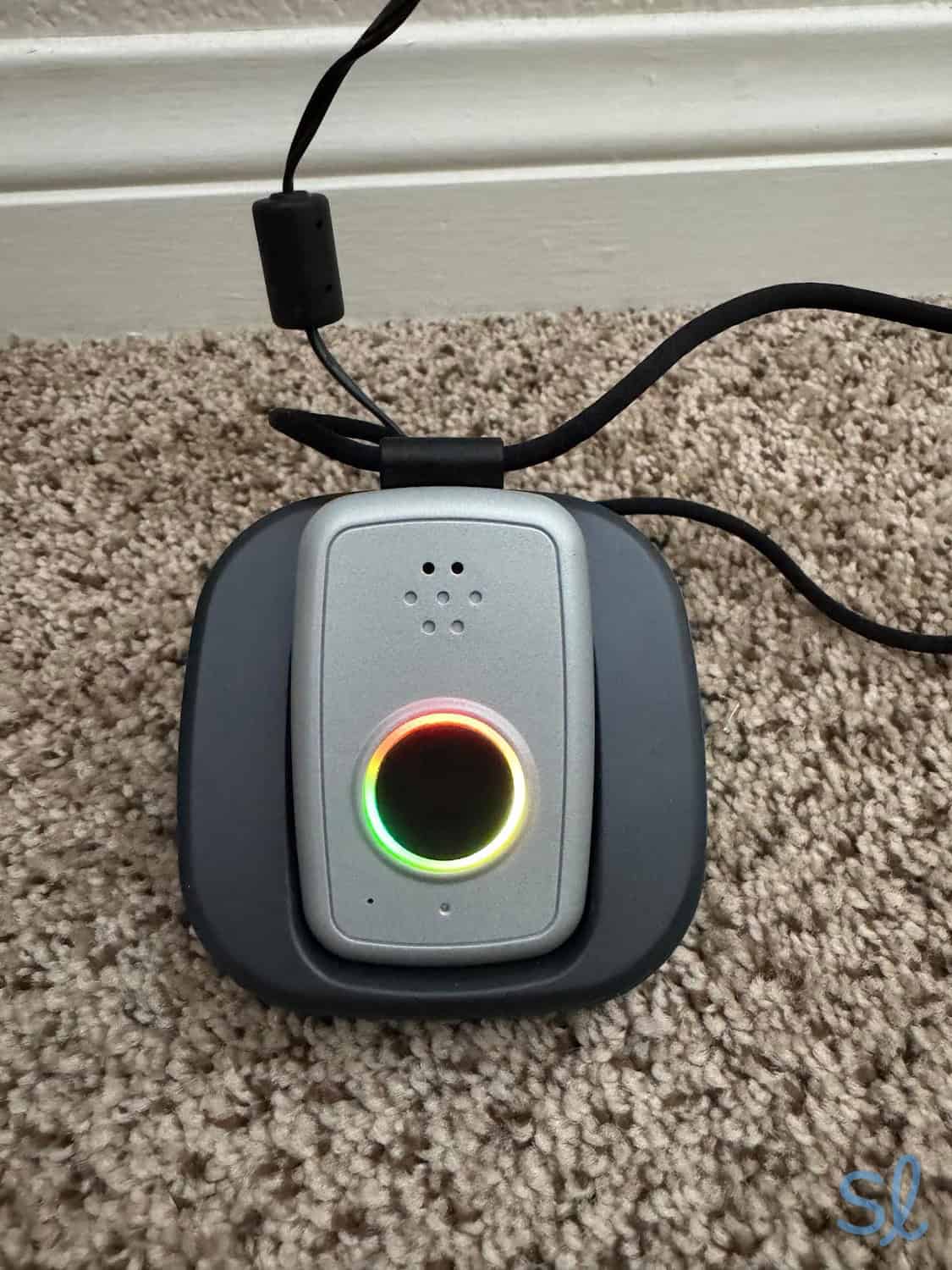
Charging MobileHelp's Solo system
You can add an automatic fall detection button for $11 per month. If you choose to purchase fall detection, it comes in the form of a separate neck pendant. If you want an all-in-one mobile device (including fall detection), consider the Micro or read our review of Medical Guardian.
MobileHelp Micro
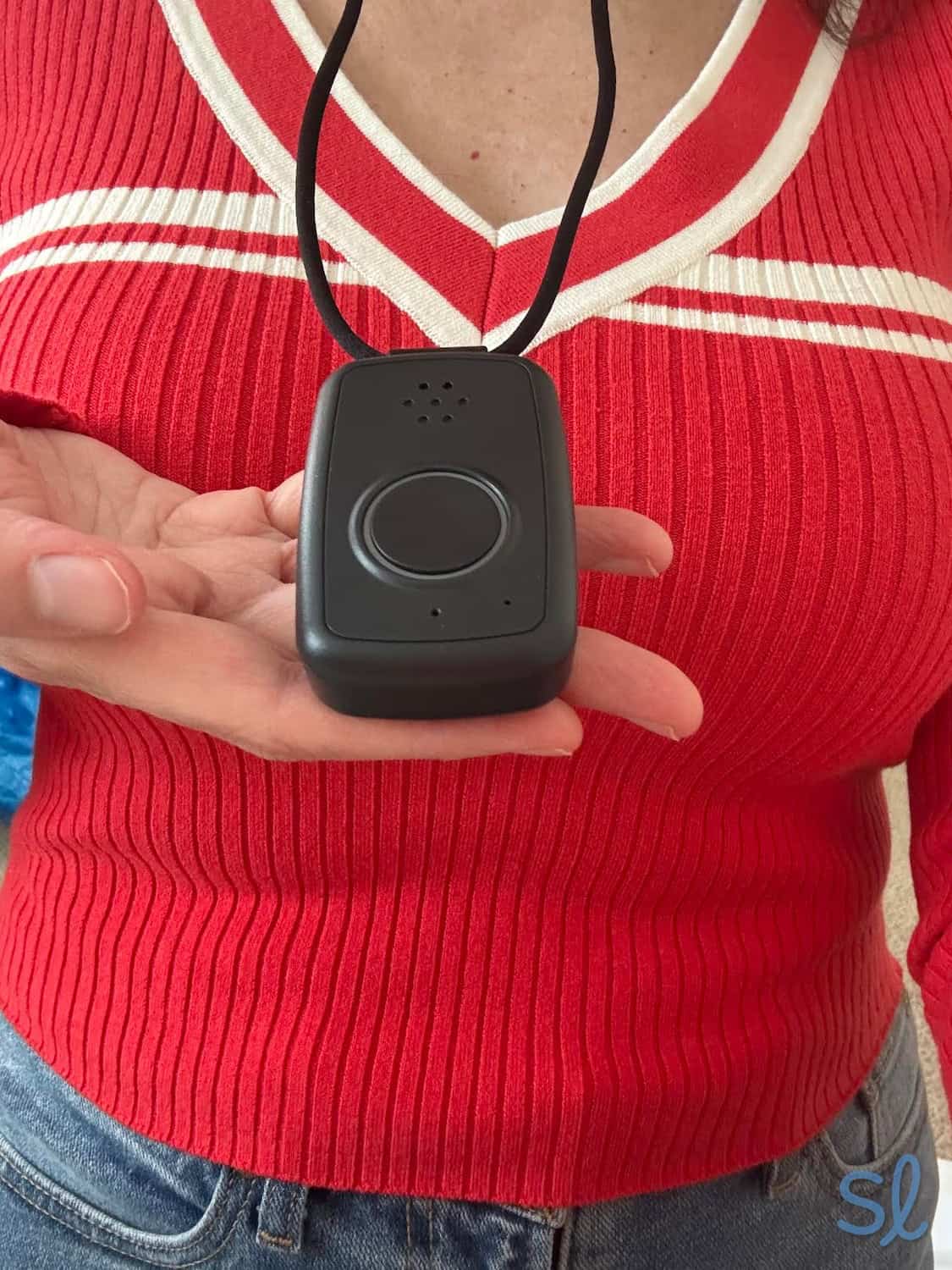
Using the MobileHelp Micro system
We received the Micro with a detachable lanyard, charging station, and free lockbox. We put on the Micro like a necklace and went out and about knowing we had 24/7 protection. It is a black device that is somewhat heavier and bulkier than other similarly priced devices on the market. However, we found the monitoring was reliable and the system was easy to use.
The device includes GPS location detection, two-way talk, optional fall detection, and a 36-hour battery life. The instructions recommend charging it every night so you’re good to go in the morning. The price for the system is $34.95 per month, which aligns with industry standards and makes it among MobileHelp’s most inexpensive mobile systems. Plus, the emergency response team is highly personalized. Operators immediately address you by name, providing reassurance of care and trust.
Home Duo Bundle
The Home Duo Bundle offers an in-home base unit, a mobile unit for when you’re away from home, and a waterproof help button that can be worn in the shower. It has GPS tracking, remote activation, 24/7 U.S.-based monitoring, and it’s compatible with MobileHelp Fall Button. The system is best for people with an active lifestyle who seek a comprehensive medical alert system. You can add an automatic fall detection button for $11 per month.
Mobile Duo Bundle
The Mobile Duo Bundle, which costs $49.95 per month, gives you two GPS medical alert systems for the price of one for you and your spouse or roommate. The system is good at home or on the go. It’s water repellant and has two help buttons, 24/7 emergency monitoring, and two-way communication in your home and away from home. You can add an automatic fall detection button for $11 per month.

We wanted a central location for our testing, so we set up the base station in the living room and made a test call from the bedroom to check if it was within range. We had no trouble connecting to the monitoring center and could hear the operator through the system’s loud speaker. We tested the mobile unit during a neighborhood stroll and found that it was just as reliable. Both systems offer solid two-way communication to MobileHelp’s response center during an emergency.
Best Value: If you’re looking for the best value, we recommend one of MobileHelp’s bundle options — Home Duo or Mobile Duo. You can save on monthly rates with a bundle compared to purchasing both systems separately.
Compare MobileHelp to Other Providers
Add-on Accessories: Pricing and Features
MobileHelp offers a few accessories and features that can be added to any package. If you’re looking for a company with more add-ons, such as jewelry pendants or smoke and carbon monoxide monitoring, you may want to consider other providers we’ve reviewed, such as LifeFone. We’ve found that MobileHelp covers the essential add-ons, however, and their rates are affordable.
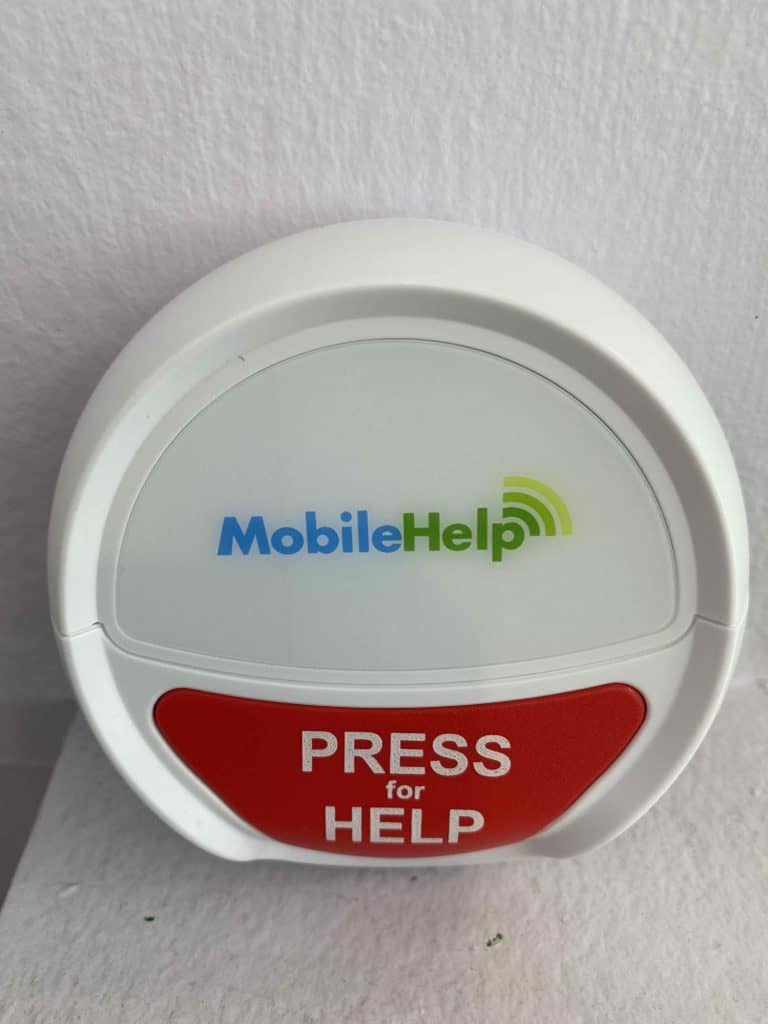
MobileHelp Wall Button
| Add-on | Features | Price |
|---|---|---|
| Fall detection pendant | -Sends an alert to the monitoring center if you fall and are unable to press the help button -Waterproof pendant that includes help button” |
$11 per month |
| Additional help button | -Neck pendant, white wrist button, and black wrist button available | $2 per month |
| Waterproof wall button | -Help button that can stick to any wall -Extra protection for tub or shower |
$2.99 per month |
| Connect premium | -Insurance for lost, stolen, or damaged equipment -Discounts on extra equipment and services -Suite of online tools and mobile app -Price lock on monthly rates for two years |
$6 per month |
| Lockbox | -Access to the door for first responders in an emergency | Included free with annual plans |
How to Get the Best Deal With MobileHelp
Here are a few tips to help you save on your MobileHelp system.
- Get MobileHelp Connect Premium. Connect Premium costs just $6 per month and comes with a boatload of perks. You’ll receive discounts on extra products and services, and you won’t have to pay the replacement cost for lost or damaged equipment, which could run up to a few hundred dollars. Connect Premium also locks in your monthly rate for two years, so you’ll never have to worry about a surprise on the next bill.
- Choose an annual payment plan. By choosing an annual payment plan, you’ll receive discounted rates compared to paying monthly. Plus, annual plans come with free shipping.
- Use the referral program. If you refer someone to MobileHelp, they will reward you and your friend with a $100 service discount after the friend purchases a system and remains enrolled for at least 60 days.
MobileHelp vs. the Competition
MobileHelp is one of our top picks for seniors, but it’s important to compare all your options. We’ll take a look at how MobileHelp stacks up to other popular brands below.
MobileHelp vs. Medical Guardian
Both companies offer 24/7 monitoring for mobile and in-home systems. Medical Guardian stands out for their sleek, high-tech equipment; useful mobile app; and variety of systems. MobileHelp’s mobile app is also not as advanced as Medical Guardian’s app, and it offers limited features for caregivers. On the other hand, MobileHelp stands out for their systems designed for two users and affordable starting rates.
MobileHelp vs. Bay Alarm Medical
Bay Alarm Medical and MobileHelp both offer simple and affordable systems. MobileHelp has a bigger in-home range of 1,400 feet compared to Bay Alarm Medical’s 1,000-foot range, so it’s a good option for people who live in large, multistory homes. Bay Alarm Medical has a few more advanced systems than MobileHelp, including one of the best medical alert watches for seniors we’ve tested.
MobileHelp vs. Life Alert
Life Alert has a lifetime guarantee for their systems, but requires a three-year contract (and complicated cancellation process). MobileHelp is contract-free. Life Alert also does not have any fall detection features and requires a pricey set up fee, unlike MobileHelp. Life Alert’s prices are also on the higher end, so MobileHelp is our pick unless brand recognition is your main priority. Read our Life Alert review to learn more.
Is MobileHelp Right for Me?
Over 3 million seniors in the U.S. own a medical alert system,1 so it’s clear the devices are a popular way to help older adults stay protected. But you may wonder: Is MobileHelp the right company for me? In our MobileHelp review, we found that the company offers affordable and reliable systems, a diverse product lineup with plenty of options, and an industry-leading monitoring service for spouses.
We would recommend MobileHelp for several types of older adults, but it’s our top pick for those who need a system built for two users. MobileHelp’s two-for-one system is highly affordable compared to companies that either charge an additional monthly fee for a spouse or require you to purchase two separate systems at full price. In addition, we recommend MobileHelp for the following groups:
- Users looking to bundle two systems
- Those who live in an area with reliable AT&T service
- Older adults who need an affordable at-home system
- Individuals who need an at-home system with a large coverage range
Our Methodology: How We Tested MobileHelp
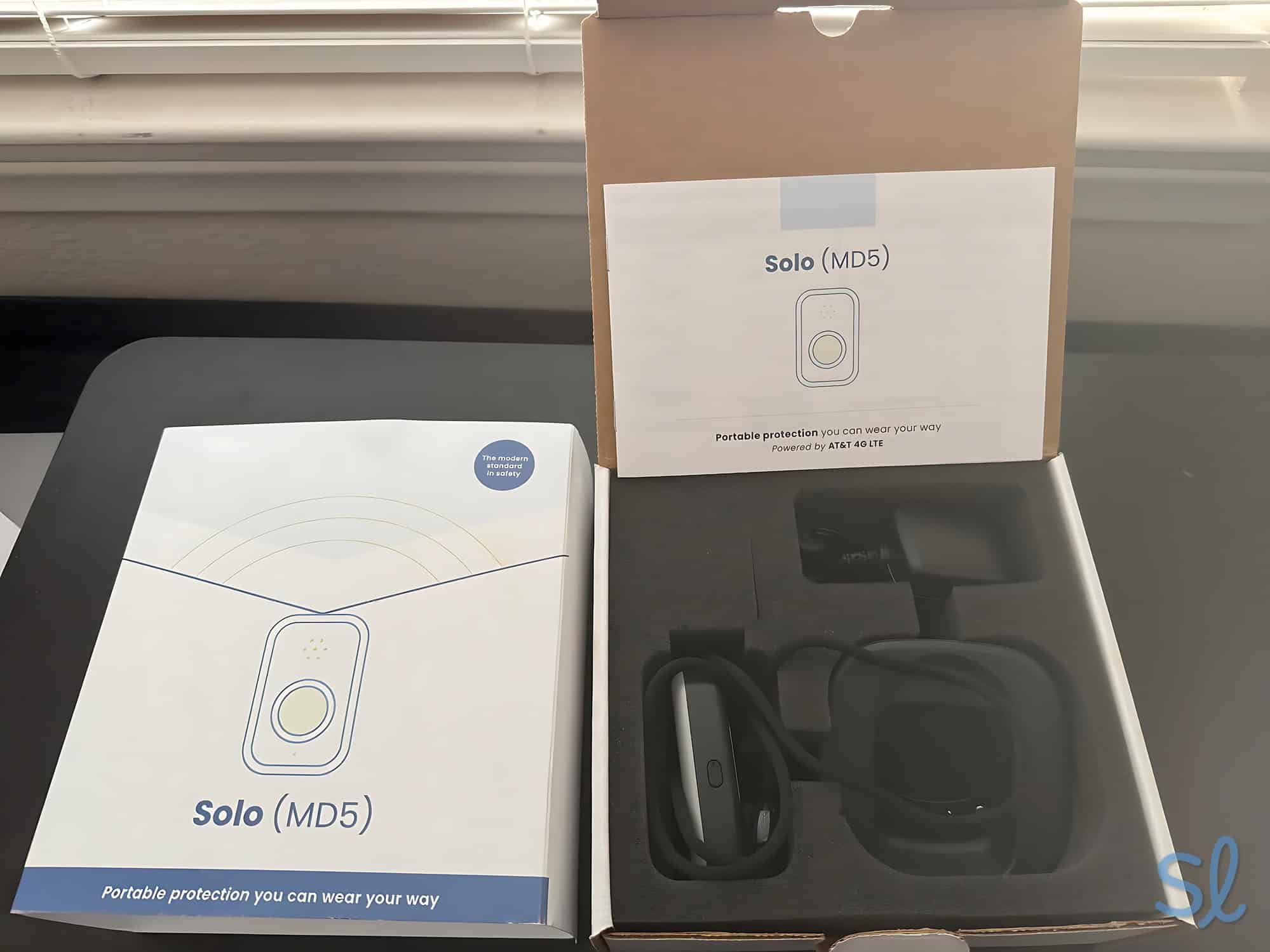
We ordered, set up, and tested all of MobileHelp s systems, including the Solo.
Our tech team conducted extensive research and hours of hands-on testing of MobileHelp’s medical alert systems. We tested the company’s systems for a week, evaluating important criteria including cost, value, response times, ease of use, quality of customer service, equipment functionality, and more. Here’s a look at how our team evaluated MobileHelp:
- Pricing: We compared and evaluated MobileHelp’s costs to measure affordability and value. We considered all prices, including monthly rates, equipment fees, seasonal discounts, and any extra costs.
- Coverage: No matter your age, older adults want dependable coverage they can rely on. We evaluated MobileHelp’s 4G LTE and 5G networks during testing. We used the systems at home, on walks, and while running errands to determine their reliability.
- Customer support: Strong customer support is a major plus, particularly for older adults who need tech support. We spoke with MobileHelp’s customer-service team multiple times to assess their response times, friendliness, and helpfulness.
- Health and safety services: We considered all of MobileHelp’s health and safety features, including 24/7 monitoring, features for caregivers, fall detection, and more.
- Response times: We tested MobileHelp’s help pendants 10 times to find average response times. Our team conducted the same test for MobileHelp’s fall detection pendants by simulating 10 test falls to determine the feature’s accuracy.
Visit our medical alert methodology guide for a closer look at our testing and rating process.
Final Thoughts on Pricing and Value for MobileHelp
MobileHelp offers affordable protection, an exceptional range for at-home systems, and monitoring for spouses. More than half of older adults in the U.S. live with a partner,2 so spouse monitoring is an essential feature. We love that MobileHelp has a two-for-the-price-of-one option that won’t break the bank. The company doesn’t offer a long list of add-on accessories, but they focus on what truly matters—keeping you safe. Starting at just $24.95 per month, MobileHelp is a solid option for inexpensive, reliable protection.
Frequently Asked Questions About MobileHelp
-
Can I travel with my MobileHelp system?
Your mobile device will work anywhere there is AT&T coverage. MobileHelp recommends that you call them before traveling to update your information.
-
How long do the batteries last?
The base station for the at-home systems will last 30 hours or more, while the battery on the help button will last for about five years. The battery for the on-the-go device will last for 24 hours when fully charged.
-
What is MobileHelp’s return policy?
You can return your MobileHelp system at any time, no questions asked. You’ll just need to call MobileHelp’s customer service team and let them know. After MobileHelp receives and processes your equipment, they will officially cancel your service. MobileHelp will then issue a prorated refund for unused service. Note that you do need to pay for return shipping.
-
Does MobileHelp require customers to sign long-term contracts?
No, MobileHelp never requires customers to sign a long-term contract. And remember, all packages have a 30-day money-back guarantee, so you can test out the equipment.
-
Do I need to have an AT&T plan to get MobileHelp?
No, you don’t need to be an AT&T customer to use MobileHelp’s cellular systems. MobileHelp will provide cellular service for your devices, so you’ll just need to make sure there is reliable AT&T coverage in your area.
Washington Post. (2019). Considering a medical alert device? Here’s what you should know before buying.
ACL. (2017). 2017 Profile of Older Americans.
Medicare. (2024). Parts of Medicare.




